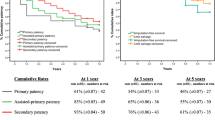Abstract
Purpose
In many patients with critical limb ischemia (CLI), transfemoral endovascular recanalization is the preferred treatment. Transpopliteal treatment may be used in patients with inaccessible groins. This retrospective study regards transpopliteal stenting of superficial femoral artery (SFA) occlusions using a 4F system.
Materials and Methods
Eleven patients (4 male and 7 female [mean age 77 years]) underwent 12 attempts of transpopliteal recanalization of long SFA occlusions (Trans-Atlantic InterSociety Consensus B through D). All patients had CLI (Rutherford 4 to 6) and were nonoperable due to poor general condition. Indications for transpopliteal access were proximal/flush SFA occlusions (n = 5), failure of antegrade recanalization (n = 4), infected femoral–femoral crossover bypass (n = 2), and occlusion of both the native SFA and the femoral–popliteal bypass (n = 1). The popliteal artery was punctured under ultrasound guidance. Occlusions were recanalized subintimally, and 4F compatible stents were implanted.
Results
Technical success rate (<30 % residual stenosis) was achieved in 83 % of cases. In two patients, stent dislocation occurred while the sheath was removed. One arteriovenous fistula was successfully treated with additional stenting. During 6-month follow-up, there were no major amputations, and three patients died from nonrelated causes. Fifty percent of patients alive after 6 months improved to Rutherford score ≤3. The duplex restenosis (>50 %) rate at 6 months was 50 %.
Conclusion
Transpopliteal primary stenting of complex SFA lesions in CLI for a temporary bypass is now technically feasible using a 4F system. Technical results are promising. Clinical results after 6 months are acceptable when taking into consideration that this approach may be the last option for limb salvage.


Similar content being viewed by others
References
Twine CP, Coulston J, Shandall A, McLain AD (2009) Angioplasty versus stenting for superficial femoral artery lesions. Cochrane Database Syst Rev 2:CD006767
Norgren L, Hiatt WR, Dormandy JA, Nehler MR, Harris KA, Fowkes FG et al (2007) Inter-society consensus for the management of peripheral arterial disease (TASC II). J Vasc Surg 45(Suppl S):S5–S67
Tønnesen KH, Sager P, Karle A, Henriksen L, Jørgensen B (1988) Percutaneous transluminal angioplasty of the superficial femoral artery by retrograde catheterization via the popliteal artery. Cardiovasc Interv Radiol 11(3):127–131
Matsi PJ, Manninen HI, Söder HK, Mustonen P, Kouri J (1995) Percutaneous transluminal angioplasty in femoral artery occlusions: primary and long-term results in 107 claudicant patients using femoral and popliteal catheterization techniques. Clin Radiol 50(4):237–244
Ye M, Zhang H, Huang X, Shi Y, Yao Q, Zhang L et al (2013) Retrograde popliteal approach for challenging occlusions of the femoral–popliteal arteries. J Vasc Surg 58(1):84–89
Brountzos EN, Moulakakis KG, Avgerinos ED, Dalainas I, G Giannakopoulos T, Kakisis J et al (2011) Retrograde transpopliteal approach of iliofemoral lesions. Vasc Endovasc Surg 45(7):646–650
Yilmaz S, Sindel T, Ceken K, Alimoğlu E, Lüleci E (2001) Subintimal recanalization of long superficial femoral artery occlusions through the retrograde popliteal approach. Cardiovasc Interv Radiol 24(3):154–160
Evans C, Peter N, Gibson M, Torrie EP, Galland RB, Magee TR (2010) Five-year retrograde transpopliteal angioplasty results compared with antegrade angioplasty. Ann R Coll Surg Engl 92(4):347–352
Noory E, Rastan A, Schwarzwälder U, Sixt S, Beschorner U, Bürgelin K et al (2009) Retrograde transpopliteal recanalization of chronic superficial femoral artery occlusion after failed re-entry during antegrade subintimal angioplasty. J Endovasc Ther 16(5):619–623
Saha S, Gibson M, Magee TR, Galland RB (2001) Torrie EP (2001) Early results of retrograde transpopliteal angioplasty of iliofemoral lesions. Cardiovasc Interv Radiol 24(6):378–382
Yilmaz S, Sindel T, Lüleci E (2005) Ultrasound-guided retrograde popliteal artery catheterization: experience in 174 consecutive patients. J Endovasc Ther 12(6):714–722
Zaitoun R, Iyer SS, Lewin RF, Dorros G (1990) Percutaneous popliteal approach for angioplasty of superficial femoral artery occlusions. Cathet Cardiovasc Diagn 21(3):154–158
McCullough KM (1993) Retrograde transpopliteal salvage of the failed antegrade transfemoral angioplasty. Australas Radiol 37(4):329–331
Muradin GS, Bosch JL, Stijnen T, Hunink MG (2001) Balloon dilation and stent implantation for treatment of femoropopliteal arterial disease: meta-analysis. Radiology 221(1):137–145
Rutherford RB, Baker JD, Ernst C, Johnston KW, Porter JM, Ahn S et al (1997) Recommended standards for reports dealing with lower extremity ischemia: revised version. J Vasc Surg 26(3):517–538
Acin F, de Haro J, Bleda S, Varela C, Esparza L (2012) Primary nitinol stenting in femoropopliteal occlusive disease: a meta-analysis of randomized controlled trials. J Endovasc Ther 19(5):585–595
Conflict of interest
Marlon Spreen, Ted Vink, Bob Knippenberg, Jim Reekers, Lukas van Dijk, Jan Wever, Randolph van Eps, Hans van Overhagen have no financial disclosures.
Author information
Authors and Affiliations
Corresponding author
Rights and permissions
About this article
Cite this article
Spreen, M., Vink, T., Knippenberg, B. et al. Transpopliteal Stenting of Femoral Occlusions in Patients With Critical Limb Ischemia Using a 4-French System. Cardiovasc Intervent Radiol 37, 908–913 (2014). https://doi.org/10.1007/s00270-014-0891-4
Received:
Accepted:
Published:
Issue Date:
DOI: https://doi.org/10.1007/s00270-014-0891-4




